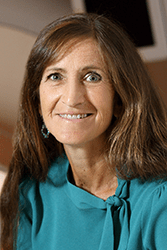Keynote: Argye Hillis
 Wednesday, November 8, 9:00 – 10:00 am
Wednesday, November 8, 9:00 – 10:00 am
Chesapeake Ballroom
Speaker: Argye E. Hillis, Professor of Neurology, Physical Medicine & Rehabilitation, and Cognitive Science, Johns Hopkins University
Chair: Brenda Rapp, Cognitive Science Department, Johns Hopkins University
Professor Hillis serves as the Executive Vice Chair of Neurology, and Director of the Cerebrovascular Division. She began her career as a Speech-Language Pathologist and Director of Neurological Rehabilitation, focusing on studies of novel treatments of aphasia and communication disorders after right hemisphere stroke. She also studied Cognitive Neuropsychology in the Cognitive Science Department at Johns Hopkins, where she later became a faculty member. Her research focused on identifying the cognitive processes underlying language and spatial representations through the study of aphasia and hemispatial neglect, and how these investigations might help focus rehabilitation. Dr. Hillis then completed medical training and neurology residency at Johns Hopkins, and integrated her training in the fields of Speech-Language Pathology and Cognitive Science with Neurology to continue her investigations of aphasia and right hemisphere cognitive and communicative impairments and how they recover. Her research combines longitudinal task-related and task-free functional imaging and structural imaging with detailed cognitive and language assessments to reveal the dynamic neural networks that underlie language and cognitive functions, such as empathy and prosody. Her lab studies changes from the acute stage of stroke through the first year of recovery, to improve our understanding how language and other cognitive functions recover after stroke and how to facilitate recovery.
Road Blocks in Brain Maps: Learning about Language from Lesions
Just as Google Maps can provide several ways of looking at routes between hubs or points of interest, various brain mapping techniques yield different ways of looking at structural and functional connections between processing areas critical for various language tasks. Lesions to the brain present road blocks, but there are generally alternative routes for information to flow from one critical area to another. These alternative routes may take longer, and errors can arise from “off roading”; but eventually the routes are made more efficient and effective as they are used more. I will discuss how various approaches to brain mapping of language at distinct times after “road blocks” can yield converging information about critical hubs and how one can get around them to recover language. I will illustrate with studies of task-related and resting state fMRI, connectome-symptom mapping, as well as structural and perfusion imaging studies of word comprehension and naming in stroke survivors at different stages of recovery. I will show that posterior superior temporal gyrus is one of the critical hubs for both word comprehension and naming early after stroke, but there important alternative routes that may be available depending on the size of the lesion.